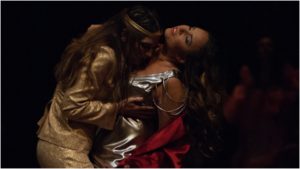
Salzburg Festival 2018 Review: L’incoronazione di Poppea
William Christie, Sonya Yoncheva & Kate Lindsey Offer New Way of Experiencing Monteverdi
By Katerina BezgachinaThe father of opera, as Claudio Monteverdi is often referred to, created the most magical music in the world about the darkest characters that had ever lived. How can we see beauty in horror and why life always juxtaposes the opposites? These questions run through your mind as you listen to “L’incoranazione di Poppea,” an ancient story of lust, seduction and power. It talks about the rise of an ambitious noblewoman, Poppea, to the Roman throne through marrying emperor Nerone.
Yoncheva Appealing & Seductive
For soprano Sonya Yoncheva, baroque repertoire is not new. It was neither her first collaboration with conductor William Christie, a leading figure in the early music performance, nor her first appearance in “L’incoranazione di Poppea.” Earlier in the career, she had been singing the part of Arnalta, Poppea’s faithful servant. Then, Yoncheva progressed to Poppea and later developed taste for more dramatic soprano roles. In Salzburg, she goes back to her roots and creates a most seductive and sexually alluring Poppea. In her opening aria “Singor, deh non partire” and “Nerone, Nerone, addio,” her voice sounds sweeter than honey and almost simulates vocal orgasm. The shiny dress with the red robe intensifies Poppea’s sexual appeal and fatal doom. At times, Yoncheva’s voice sounds a bit big and overshadows a smaller baroque orchestra. Yet, her passionate performance and seductive poses paint a convincing character of an ambitious and power thirsty woman.
Lindsey’s Neurotic Nerone
Nerone, sung by a dark-voiced mezzo-soprano Kate Lindsay, is a neurotic, ruthless and greedy ruler, who begs for love. He cannot get enough of his voluptuous lover and removes anyone who stands in the way of his sexual pleasures, including his teacher-philosopher Seneca, sung by baritone Renato Dolcini. Their opposing worlds clash in the exchange “Son risoluto al fine,” when Nerone shares that he has decided to dismiss his wife Ottavia to marry Poppea. To this, Seneca responds that he is not free to break the rules and the move would be unpopular. However, the battle is lost, and its cost is human life. Seneca is only well aware of this as his melancholy and stoic character come to life in the gloomy and dark aria about loneliness “Solitudine amata” and later in his farewell “Amici, e giunta l’ora,” masterfully rendered by Dolcini.
Broken Characters
Nerone’s wife, Ottavia, French mezzo-soprano Stephanie d’Oustrac, is a stoic aristocratic woman, abandoned and deposed by a tyrant. However, her will is not broken. Her farewell to Rome, “Addio Rome, addio partia, amici addio,” shows that she goes into exile with dignity.
Another set of characters – and a pair of lovers – are Ottone, countertenor Carlo Vistoli, and Drusilla, sung by soprano Ana Quintans. Ottone is Poppea’s former lover, who tries to find consolation in the arms of another woman. You can almost hear his weeping as he sings “Drusilla ho in bocca, e ho Poppea nel core.” Vistoli conveys this indecisiveness and frustration though every line he sings. His only bold act, and singing, come at the end, when Drusilla is falsely accused of attempted assassination of Poppea. Ottone finds courage to confess that he has planned it. Then, the pair joins Ottavia in her exile from Roma.
The final duet of the opera, between Poppea and Nerone, “Pur ti miro” is probably the most beguiling music in the whole operatic oeuvre. Yoncheva and Lindsay delivered it perfectly as they position themselves on the opposite sides of the stage to be connected only through sound. This music brings peace and joy to senses, soothes and calms. However, behind its outward harmony stand death and human suffering. The death of Nero’s teacher Seneca, the banishment of his wife Ottavia and deaths yet to come — of Poppea and Nerone.
Conversing Through Video & Music
Baroque musicians, dancers, video projections, opulent decorations and bizarre costumes form another prominent part of the production. These create a separate narration and performance within the opera as if telling the same story but on a different level. Dancers from the Salzburg Experimental Academy of Dance project mimic characters and their inner motives through movements. Rich baroque stage decorations, created by Jan Lauwers, offer exquisite settings for this brutal story. However, there is nothing exaggerated or artificial in it. Everything happens front of our eyes in a very matter of fact and casual way. The main characters of the opera do not make grant appearance on stage, they simply emerge from the ranks of musicians, apart from Nerone and Poppea, and walk into their roles from the orchestra pit.
At the same time, there is no conductor towering over the orchestra. William Christie prefers to take his seat at the harpsichord and only gives indication for a tempo or accent from time to time. He does not conduct; he talks through music to his fellow musicians, singers and the audience.
At the end of the evening, the story keeps haunting you as the beauty of Monteverdi’s music and Lauwers’ world around it clash with the ugliness and darkness of the human world of greed and ambition.


